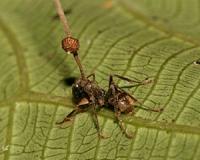| . |  |
. |
Leicester UK (SPX) May 11, 2011 Scientists at Royal Holloway, University of London and the University of Leicester have discovered animals searching for food do not stick to a complicated pattern of movement as previously thought but tend to wander about randomly. It was previously believed that when searching for food, animals move in very peculiar way called a Levy flight where they move small distances most of the time, but occasionally move a very long distance. This idea was based on studies in which many animals, like albatrosses or sharks, were tracked. However scientists have been analysing video records of aphids, small sap-sucking insects to find out how they move and have discovered that they wander about randomly, much like inanimate molecules move, and some tend to walk much more than others. The study is published in the journal Proceedings of the National Academy of Sciences of the USA. Dr Alla Mashanova, from the School of Biological Sciences at Royal Holloway, said: "It was the large variation between individuals - with some moving very little and some moving a lot - that previously created the impression of the Levy flight." The researchers recorded the length of movement by all the aphids and used this data to build two mathematical models to carry out a more detailed statistical analysis. Dr Sergei Petrovskii, from the Department of Mathematics at Leicester says: "It is amazing how very simple mathematical models can sometimes be used to explain very complicated phenomena." The researchers say understanding how animals move is important, for instance, for hunting, to design nature reserves and to predict pest outbreaks and understand the spread of diseases. Professor Vincent Jansen from the School of Biological Sciences at Royal Holloway said: "Understanding individual variation is crucial for interpreting the collective movement patterns of animals. This research will open the way to better understand animal search and behaviour and work out how it has evolved."
Share This Article With Planet Earth
Related Links University of Leicester Darwin Today At TerraDaily.com
 Zombie ants have fungus on the brain
Zombie ants have fungus on the brainWashington DC (SPX) May 10, 2011 Tropical carpenter ants (Camponotus leonardi) live high up in the rainforest canopy. When infected by a parasitic fungus (Ophiocordyceps unilateralis) the behaviour of the ants is dramatically changed. They become erratic and zombie-like, and are manipulated by the fungus into dying at a spot that provides optimal conditions for fungal reproduction. New research, published in BioMed Centra ... read more |
|
| The content herein, unless otherwise known to be public domain, are Copyright 1995-2010 - SpaceDaily. AFP and UPI Wire Stories are copyright Agence France-Presse and United Press International. ESA Portal Reports are copyright European Space Agency. All NASA sourced material is public domain. Additional copyrights may apply in whole or part to other bona fide parties. Advertising does not imply endorsement,agreement or approval of any opinions, statements or information provided by SpaceDaily on any Web page published or hosted by SpaceDaily. Privacy Statement |